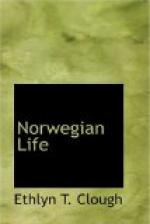The Scandinavian countries are for the first time mentioned by the historians of antiquity in an account of a journey which Pyteas from Massilia (the present Marseille) made throughout Northern Europe, about 300 B.C. He visited Britain, and there heard of a great country, Thule, situated six days’ journey to the north, and verging on the Arctic Sea. The inhabitants in Thule were an agricultural people who gathered their harvest into big houses for threshing, on account of the very few sunny days and the plentiful rain in their regions. From corn and honey they prepared a beverage (probably mead).
Pliny the Elder, who himself visited the shores of the Baltic in the first century after Christ, is the first to mention plainly the name of Scandinavia. He says that he has received advices of immense islands “recently discovered from Germany.” The most famous of these islands was Scandinavia, of as yet unexplored size; the known parts were inhabited by a people called hilleviones, who gave it the name of another world. He mentions Scandia, Nerigon, the largest of them all, and Thule. Scandia and Scandinavia are only different forms of the same name, denoting the southernmost part of the peninsula, and still preserved in the name of the province of Scania in Sweden. Nerigon stands for Norway, the northern part of which is mentioned as an island by the name of Thule. The classical writers were ignorant of the fact that Scandinavia was one great peninsula, because the northern parts were as yet uninhabited and their physical connection with Finland and Russia unknown. That the Romans were later acquainted with the Scandinavian countries is evidenced from the fact that great numbers of Roman coins have been found in excavating, also vessels of bronze and glass, weapons, etc., as well as works of art, all turned out of the workshops in Rome or its provinces. There, no doubt, existed a regular traffic over the Baltic, through Germany, between the Scandinavian countries and the Roman provinces.
The first settlers probably knew little of agriculture, but made their living by fishing and hunting. In time, however, they commenced to clear away the timber that covered the land in the valleys and on the sides of the mountains and to till the ground. At the earliest times of which the historical tales or Sagas tell us anything with regard to the social conditions, the land was divided among the free peasant-proprietors, or bonde class. Bonde, in English translation, is usually called peasant; but this is not an equivalent; for with the word “peasant” we associate the idea of inferior social condition to the landed aristocracy of the country, while these peasants or bondes were themselves the highest class in the country. The land owned by a peasant was called his udal. By udal-right the land was kept in the family, and it could not be alienated or forfeited from the kindred who were udal-born to




